brake fluid YAMAHA MT-10 2018 Owners Manual
[x] Cancel search | Manufacturer: YAMAHA, Model Year: 2018, Model line: MT-10, Model: YAMAHA MT-10 2018Pages: 108, PDF Size: 8.97 MB
Page 6 of 108

Table of contentsSafety information........................... 1-1
Description ....................................... 2-1
Left view ......................................... 2-1
Right view ....................................... 2-2
Controls and instruments................ 2-3
Special features ............................... 3-1
Cruise control system ..................... 3-1
D-mode (drive mode)...................... 3-3
Traction control system .................. 3-4
Quick shift system ...... .................... 3-6
Instrument and control
functions ........................................... 4-1
Immobilizer system ..... .................... 4-1
Main switch/steering lock................ 4-2
Handlebar switches ........................ 4-3
Indicator lights and warning lights ............................................ 4-5
Multi-function meter unit ................. 4-8
Clutch lever................................... 4-16
Shift pedal..... ............................ .... 4-16
Brake lever ................................... 4-17
Brake pedal .................................. 4-17
ABS .............................................. 4-18
Fuel tank cap ................................ 4-19
Fuel............................................... 4-19
Fuel tank overflow hose................ 4-21
Catalytic converter ........................ 4-21
Seat .............................................. 4-22 Adjusting the front fork ................. 4-23
Adjusting the shock absorber
assembly................................... 4-24
Luggage strap holders . ................ 4-27
EXUP system ............................... 4-27
Auxiliary DC jack .......................... 4-28
Sidestand ..................................... 4-28
Ignition circuit cut- off system ........ 4-29
For your safety – pre-operation
checks .............................................. 5-1
Operation and important riding
points ................................................ 6-1
Starting the engine ......................... 6-1
Shifting ........................................... 6-2
Tips for reducing fuel consumption ............................... 6-3
Engine break-in .............................. 6-3
Parking ........................................... 6-4
Periodic maintenance and
adjustment ....................................... 7-1
Owner’s tool kits ............................. 7-2
Periodic maintenance chart for the emission control system ....... 7-3
General maintenance and lubrication chart .......................... 7-5
Checking the spark plugs ............... 7-9
Canister ........................................ 7-10
Engine oil ..................................... 7-10 Coolant ........................................ 7-14
Air filter element ........................... 7-15
Checking the engine idling
speed............ ............................ 7-15
Checking the throttle grip free
play ........................................... 7-16
Valve clearance ........................... 7-16
Tires ............................................. 7-16
Cast wheels ................................. 7-19
Adjusting the clutch lever free play ........................................... 7-19
Checking the brake lever free play ........................................... 7-20
Brake light switches ..................... 7-20
Checking the front and rear brake pads................................ 7-21
Checking the brake fluid level ...... 7-21
Changing the brake fluid .............. 7-22
Drive chain slack.......................... 7-23
Cleaning and lubricating the
drive chain ................................ 7-24
Checking and lubricating the cables ....................................... 7-25
Checking and lubricating the throttle grip and cable ............... 7-25
Checking and lubricating the brake and shift pedals .............. 7-25
Checking and lubricating the
brake and clutch levers ............ 7-26
Checking and lubricating the sidestand .................................. 7-27B67-9-E2.book 1 ページ 2018年6月5日 火曜日 午前9時7分
Page 14 of 108

Description
2-2
12
3
4
5
6
7
8
9
10
11
12
EAU10421
Right view
8
10 9 7
1
3
2
4, 5, 6
1. Fuses (page 7-30)
2. Owner’s tool kit (page 7-2)
3. Fuel tank cap (page 4-19)
4. Spring preload adjuster (page 4-23)
5. Rebound damping force adjuster (page 4-23)
6. Compression damping force adjuster (page 4-23)
7. Coolant reservoir (page 7-14)
8. Engine oil filler cap (page 7-10) 9. Brake pedal (page 4-17)
10.Rear brake fluid reservoir (page 7-21)
B67-9-E2.book 2 ページ 2018年6月5日 火曜日 午前9時7分
Page 15 of 108
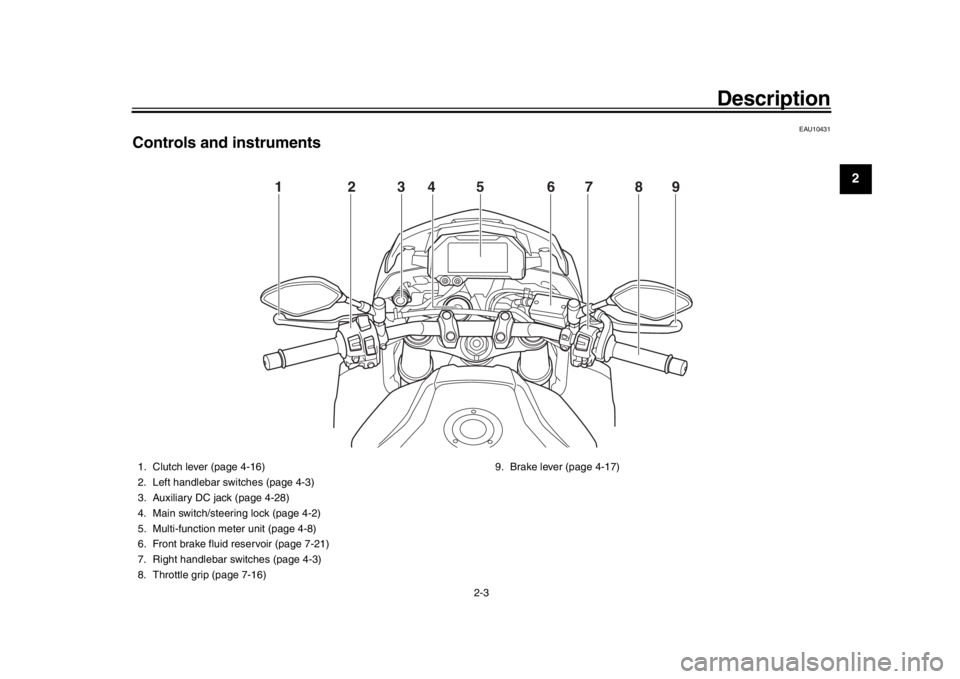
Description
2-3
123
4
5
6
7
8
9
10
11
12
EAU10431
Controls and instruments
12 456789
3
1. Clutch lever (page 4-16)
2. Left handlebar switches (page 4-3)
3. Auxiliary DC jack (page 4-28)
4. Main switch/steering lock (page 4-2)
5. Multi-function meter unit (page 4-8)
6. Front brake fluid reservoir (page 7-21)
7. Right handlebar switches (page 4-3)
8. Throttle grip (page 7-16) 9. Brake lever (page 4-17)
B67-9-E2.book 3 ページ 2018年6月5日 火曜日 午前9時7分
Page 52 of 108

5-1
1
2
3
45
6
7
8
9
10
11
12
For your safety – pre-operation checks
EAU15599
Inspect your vehicle each time you use it to make sure the vehi cle is in safe operating condition. Always follow the inspection
and maintenance procedures and schedules described in the Owner’s Manual.
WARNING
EWA11152
Failure to inspect or maintain the vehicle properly increases the possibility of an accident or equipment damage.
Do not operate the vehicle if you find any problem. If a problem cannot be corrected by the procedures provided inthis manual, have the vehicle inspected by a Yamaha dealer.
Before using this vehicle, check the following points:
ITEM CHECKS PAGE
Fuel Check fuel level in fuel tank.
Refuel if necessary.
Check fuel line for leakage.
Check fuel tank breather/overflow hose
for obstructions, cracks or damage, and
check hose connection. 4-19, 4-21
Engine oil Check oil level in engine.
If necessary, add recommended oil to specified level.
Check vehicle for oil leakage. 7-10
Coolant Check coolant level in reservoir.
If necessary, add recommended coolant to specified level.
Check cooling system for leakage. 7-14
Front brake Check operation.
If soft or spongy, have Yamaha dealer bleed hydraulic system.
Check brake pads for wear.
Replace if necessary.
Check fluid level in reservoir.
If necessary, add specified brake fluid to specified level.
Check hydraulic system for leakage. 7-21
B67-9-E2.book 1 ページ 2018年6月5日 火曜日 午前9時7分
Page 53 of 108

For your safety – pre-operation checks
5-2
1
2
3
456
7
8
9
10
11
12
Rear brake Check operation.
If soft or spongy, have Yamaha dealer bleed hydraulic system.
Check brake pads for wear.
Replace if necessary.
Check fluid level in reservoir.
If necessary, add specified brake fluid to specified level.
Check hydraulic system for leakage. 7-21
Clutch Check operation.
Lubricate cable if necessary.
Check lever free play.
Adjust if necessary. 7-19
Throttle grip Make sure that operation is smooth.
Check throttle grip free play.
If necessary, have Yamaha dealer adjust th
rottle grip free play and lubricate cable
and grip housing. 7-16, 7-25
Control cables Make sure that operation is smooth.
Lubricate if necessary. 7-25
Drive chain Check chain slack.
Adjust if necessary.
Check chain condition.
Lubricate if necessary. 7-23, 7-24
Wheels and tires Check for damage.
Check tire condition and tread depth.
Check air pressure.
Correct if necessary. 7-16, 7-19
Brake and shift pedals Make sure that operation is smooth.
Lubricate pedal pivoting points if necessary. 7-25
Brake and clutch levers Make sure that operation is smooth.
Lubricate lever pivoting points if necessary. 7-26
Sidestand Make sure that operation is smooth.
Lubricate pivot if necessary. 7-27
Chassis fasteners Make sure that all nuts, bolts and screws are properly tightened.
Tighten if necessary. —
ITEM CHECKS PAGE
B67-9-E2.book 2 ページ 2018年6月5日 火曜日 午前9時7分
Page 63 of 108

Periodic maintenance and adjustment
7-5
1
2
3
4
5
678
9
10
11
12
EAU71351
General maintenance an d lubrication chartNO. ITEM CHECK OR MAINTENANCE JOB ODOMETER READING
ANNUAL
CHECK
1000 km
(600 mi) 10000 km
(6000 mi) 20000 km
(12000 mi) 30000 km
(18000 mi) 40000 km
(24000 mi)
1 *Diagnostic system
check Perform dynamic inspection using
Yamaha diagnostic tool.
Check the error codes.
2 *Air filter element Replace. Every 40000 km (24000 mi)
3Clutch Check operation.
Adjust.
4 *Front brake Check operation, fluid level, and
for fluid leakage.
Replace brake pads if necessary.
5 *Rear brake Check operation, fluid level, and
for fluid leakage.
Replace brake pads if necessary.
6 *Brake hoses Check for cracks or damage.
Replace. Every 4 years
7 *Brake fluid Change. Every 2 years
8 *Wheels Check runout and for damage.
Replace if necessary.
9 *Tires Check tread depth and for
damage.
Replace if necessary.
Check air pressure.
Correct if necessary.
10 *Wheel bearings Check bearing for looseness or
damage.
11 *Swingarm pivot
bearings Check operation and for
excessive play.
Lubricate with lithium-soap-based grease. Every 50000 km (30000 mi)
B67-9-E2.book 5 ページ 2018年6月5日 火曜日 午前9時7分
Page 66 of 108
Periodic maintenance and adjustment
7-8
1
2
3
4
5
67
8
9
10
11
12
EAU72800
TIP
Air filter
This model’s air filter is equipped wi th a disposable oil-coated paper elemen t, which must not be cleaned with com-
pressed air to avoid damaging it.
The air filter element needs to be replaced more fr equently when riding in unusually wet or dusty areas.
Hydraulic brake service
Regularly check and, if necessary, correct the brake fluid level.
Every two years replace the internal components of t he brake master cylinders and calipers, and change the brake
fluid. Replace the brake hoses every four years and if cracked or damaged.
B67-9-E2.book 8 ページ 2018年6月5日 火曜日 午前9時7分
Page 79 of 108
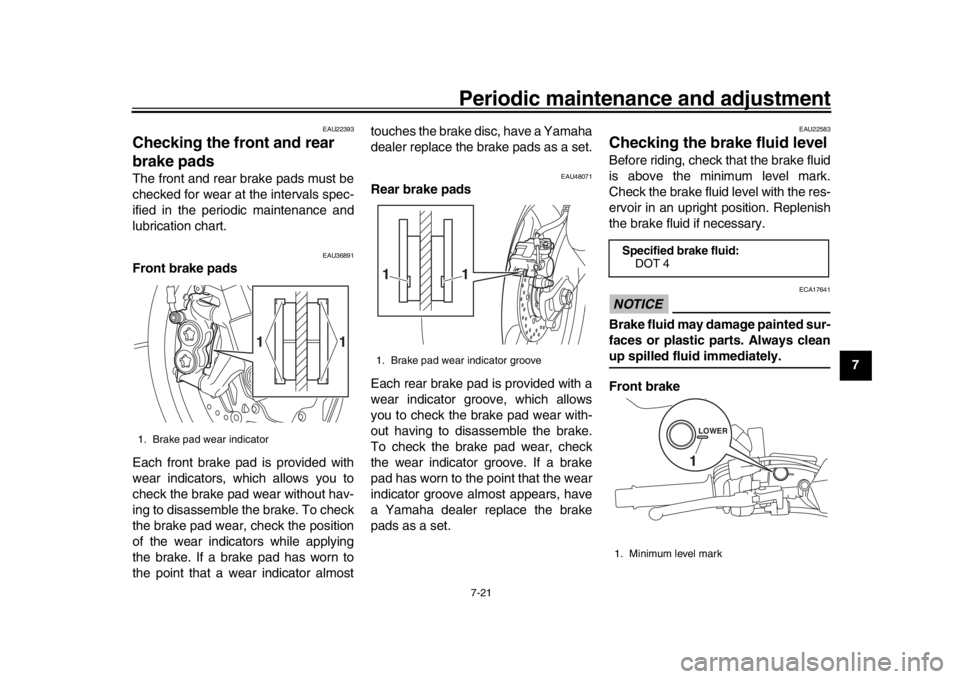
Periodic maintenance and adjustment7-21
1
2
3
4
5
678
9
10
11
12
EAU22393
Checking the fr ont and rear
brake padsThe front and rear brake pads must be
checked for wear at the intervals spec-
ified in the periodic maintenance and
lubrication chart.
EAU36891
Front brake pads
Each front brake pad is provided with
wear indicators, which allows you to
check the brake pad wear without hav-
ing to disassemble the brake. To check
the brake pad wear, check the position
of the wear indicators while applying
the brake. If a brake pad has worn to
the point that a wear indicator almost touches the brake disc, have a Yamaha
dealer replace the brake pads as a set.
EAU48071
Rear brake pads
Each rear brake pad is provided with a
wear indicator groove, which allows
you to check the brake pad wear with-
out having to disassemble the brake.
To check the brake pad wear, check
the wear indicator groove. If a brake
pad has worn to the point that the wear
indicator groove almost appears, have
a Yamaha dealer replace the brake
pads as a set.
EAU22583
Checking the brake fluid levelBefore riding, check that the brake fluid
is above the minimum level mark.
Check the brake fluid level with the res-
ervoir in an upright position. Replenish
the brake fluid if necessary.NOTICE
ECA17641
Brake fluid may damage painted sur-
faces or plastic parts. Always cleanup spilled fluid immediately.
Front brake
1. Brake pad wear indicator
1
1
1. Brake pad wear indicator groove
1
1
Specified brake fluid:
DOT 41. Minimum level mark
LOWER1
B67-9-E2.book 21 ページ 2018年6月5日 火曜日 午前9時7分
Page 80 of 108
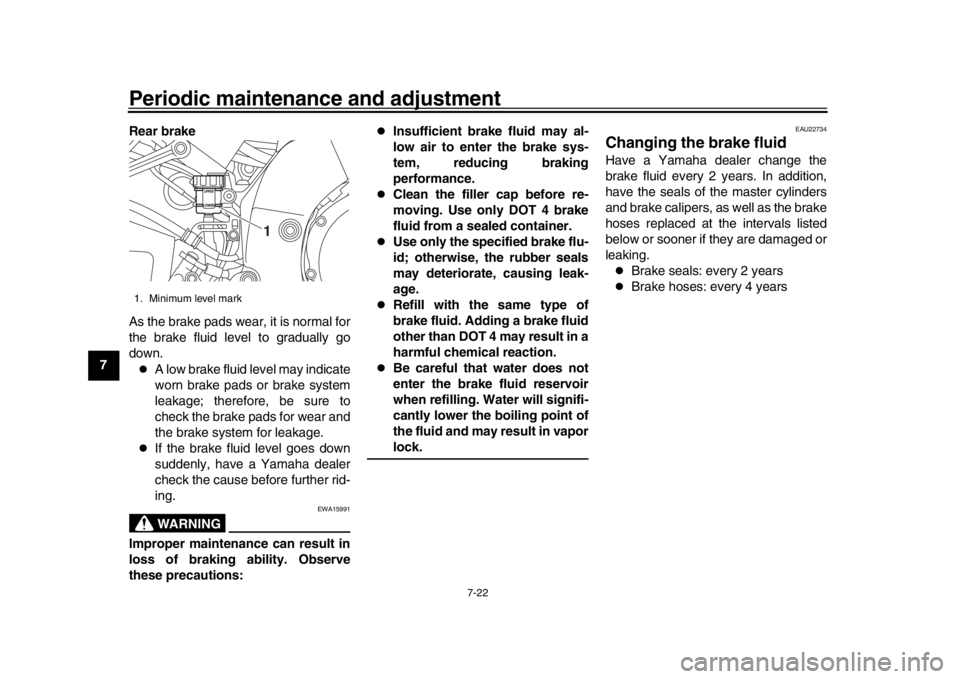
Periodic maintenance and adjustment
7-22
1
2
3
4
5
67
8
9
10
11
12 Rear brake
As the brake pads wear, it is normal for
the brake fluid level to gradually go
down.
A low brake fluid level may indicate
worn brake pads or brake system
leakage; therefore, be sure to
check the brake pads for wear and
the brake system for leakage.
If the brake fluid level goes down
suddenly, have a Yamaha dealer
check the cause before further rid-
ing.WARNING
EWA15991
Improper maintenance can result in
loss of braking ability. Observe
these precautions:
Insufficient brake fluid may al-
low air to enter the brake sys-
tem, reducing braking
performance.
Clean the filler cap before re-
moving. Use only DOT 4 brake
fluid from a sealed container.
Use only the specified brake flu-
id; otherwise, the rubber seals
may deteriorate, causing leak-
age.
Refill with the same type of
brake fluid. Adding a brake fluid
other than DOT 4 may result in a
harmful chemical reaction.
Be careful that water does not
enter the brake fluid reservoir
when refilling. Water will signifi-
cantly lower the boiling point of
the fluid and may result in vaporlock.
EAU22734
Changing the brake fluidHave a Yamaha dealer change the
brake fluid every 2 years. In addition,
have the seals of the master cylinders
and brake calipers, as well as the brake
hoses replaced at the intervals listed
below or sooner if they are damaged or
leaking.
Brake seals: every 2 years
Brake hoses: every 4 years
1. Minimum level mark
1
B67-9-E2.book 22 ページ 2018年6月5日 火曜日 午前9時7分
Page 96 of 108
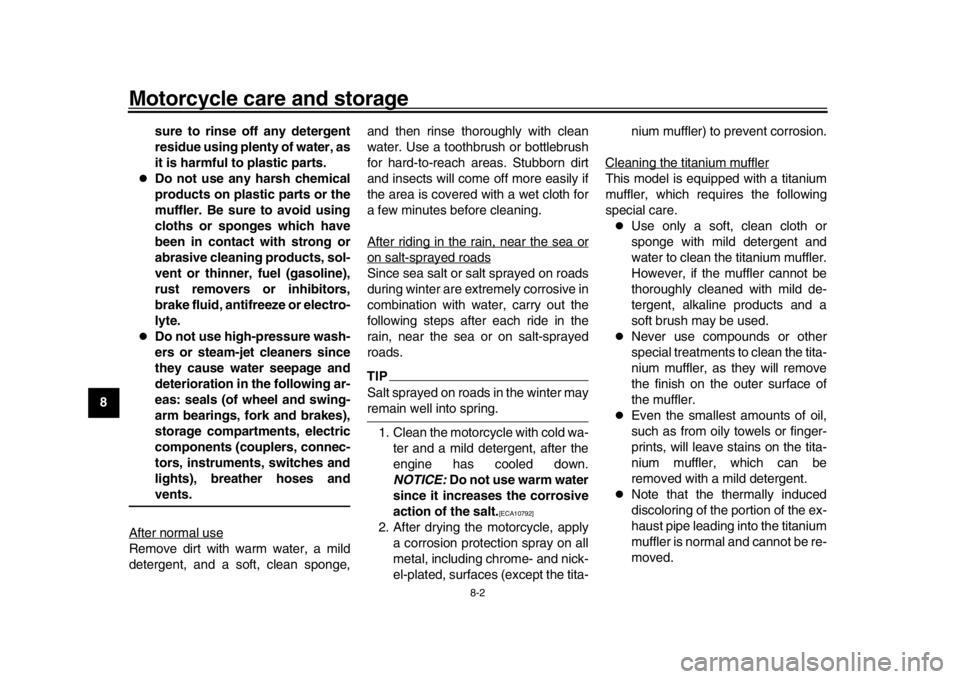
Motorcycle care and storage
8-2
1
2
3
4
5
6
78
9
10
11
12 sure to rinse off any detergent
residue using plenty of water, as
it is harmful to plastic parts.
Do not use any harsh chemical
products on plastic parts or the
muffler. Be sure to avoid using
cloths or sponges which have
been in contact with strong or
abrasive cleaning products, sol-
vent or thinner, fuel (gasoline),
rust removers or inhibitors,
brake fluid, antifreeze or electro-
lyte.
Do not use high-pressure wash-
ers or steam-jet cleaners since
they cause water seepage and
deterioration in the following ar-
eas: seals (of wheel and swing-
arm bearings, fork and brakes),
storage compartments, electric
components (couplers, connec-
tors, instruments, switches and
lights), breather hoses andvents.
After normal use
Remove dirt with warm water, a mild
detergent, and a soft, clean sponge, and then rinse thoroughly with clean
water. Use a toothbrush or bottlebrush
for hard-to-reach areas. Stubborn dirt
and insects will come off more easily if
the area is covered with a wet cloth for
a few minutes before cleaning.
After riding in the rain, near the sea or
on salt-sprayed roadsSince sea salt or salt sprayed on roads
during winter are extremely corrosive in
combination with water, carry out the
following steps after each ride in the
rain, near the sea or on salt-sprayed
roads.TIPSalt sprayed on roads in the winter mayremain well into spring.
1. Clean the motorcycle with cold wa- ter and a mild detergent, after the
engine has cooled down.
NOTICE: Do not use warm water
since it increases the corrosive
action of the salt.
[ECA10792]
2. After drying the motorcycle, apply a corrosion protection spray on all
metal, including chrome- and nick-
el-plated, surfaces (except the tita- nium muffler) to prevent corrosion.
Cleaning the titanium muffler
This model is equipped with a titanium
muffler, which requires the following
special care.
Use only a soft, clean cloth or
sponge with mild detergent and
water to clean the titanium muffler.
However, if the muffler cannot be
thoroughly cleaned with mild de-
tergent, alkaline products and a
soft brush may be used.
Never use compounds or other
special treatments to clean the tita-
nium muffler, as they will remove
the finish on the outer surface of
the muffler.
Even the smallest amounts of oil,
such as from oily towels or finger-
prints, will leave stains on the tita-
nium muffler, which can be
removed with a mild detergent.
Note that the thermally induced
discoloring of the portion of the ex-
haust pipe leading into the titanium
muffler is normal and cannot be re-
moved.
B67-9-E2.book 2 ページ 2018年6月5日 火曜日 午前9時7分